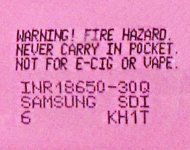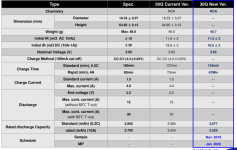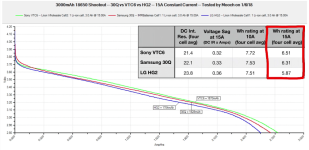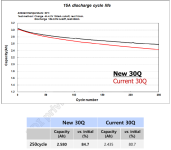So I've been running a series 10S8P split pack of Samsung 25Rs in the original blue wrappers since 2015, and frankly they've been really great. I've probably put them through roughly 150+ or so charge cycles always staying within the limits of 4.1V-3.25V/cell, and CAv3 reports an overall pack resistance .09 to .095 ohms today from .07 ohms originally.
While my packs are still going strong, after installing the Nucular 12F controller, the "more power" bug has hit hard. I can't stop thinking about it, I need to upgrade! LOL.
Normally I'd just push the 25R's harder, but my pack construction was not ideal having used only .15x7mm thick nickel H-strips to make the series connections so I've always limited the total battery amps to 50 which resulted in a maximum 4kW discharge limit (talk about babying the 25Rs). I want to double this limit with a new pack, and rather than try and increase the current carrying capacity of my old packs, another reason I want to upgrade is to increase total capacity.
The split pack configuration has worked out very well for me - parallel config for charging, relying on the icharger3010b for balancing, and series config in use. I'm planning to continue to use a split pack configuration, but fit 10S10P this time around. With a 100A battery limit, the max current/cell would be 10A. That said, the three characteristics I'm looking for with new 18650 cells are:
1. Relatively low voltage sag under a max 10A/cell load
2. Increased capacity over the 2500 mah 25Rs
3. Longevity equal to or better than what I've gotten with the 25Rs.
I've been poking around the forum to gauge what's what in 2021, and honestly, things don't look too much different for cylindrical li-ion cells coming from the 2014/2015 era. Based mostly on Docware's excellent Li-ion cells cycle aging thread and the contributing posts there, it looks like the cells that would best suit my requirements are:
1. Sony VTC6
2. LG HG2
3. Sony VTC5D (just throwing these in the mix as this looks comparable to the VTC6 and the vendor I bought from last time appears to offer these as an option as well)
That said, anyone have a strong opinion one way or the other as to which batteries I should choose? Or better yet, any insiders think I should wait a little longer for some new next level battery that's just about to hit the market?
While my packs are still going strong, after installing the Nucular 12F controller, the "more power" bug has hit hard. I can't stop thinking about it, I need to upgrade! LOL.
Normally I'd just push the 25R's harder, but my pack construction was not ideal having used only .15x7mm thick nickel H-strips to make the series connections so I've always limited the total battery amps to 50 which resulted in a maximum 4kW discharge limit (talk about babying the 25Rs). I want to double this limit with a new pack, and rather than try and increase the current carrying capacity of my old packs, another reason I want to upgrade is to increase total capacity.
The split pack configuration has worked out very well for me - parallel config for charging, relying on the icharger3010b for balancing, and series config in use. I'm planning to continue to use a split pack configuration, but fit 10S10P this time around. With a 100A battery limit, the max current/cell would be 10A. That said, the three characteristics I'm looking for with new 18650 cells are:
1. Relatively low voltage sag under a max 10A/cell load
2. Increased capacity over the 2500 mah 25Rs
3. Longevity equal to or better than what I've gotten with the 25Rs.
I've been poking around the forum to gauge what's what in 2021, and honestly, things don't look too much different for cylindrical li-ion cells coming from the 2014/2015 era. Based mostly on Docware's excellent Li-ion cells cycle aging thread and the contributing posts there, it looks like the cells that would best suit my requirements are:
1. Sony VTC6
2. LG HG2
3. Sony VTC5D (just throwing these in the mix as this looks comparable to the VTC6 and the vendor I bought from last time appears to offer these as an option as well)
That said, anyone have a strong opinion one way or the other as to which batteries I should choose? Or better yet, any insiders think I should wait a little longer for some new next level battery that's just about to hit the market?







